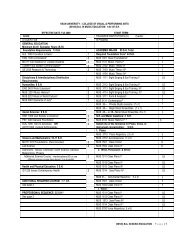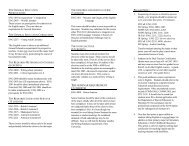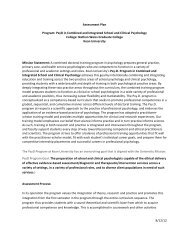GeorGe SeGal - Kean University
GeorGe SeGal - Kean University
GeorGe SeGal - Kean University
Create successful ePaper yourself
Turn your PDF publications into a flip-book with our unique Google optimized e-Paper software.
III: Now on View<br />
What then are we to make of the works in this present exhibition, particularly in terms<br />
of portraiture?<br />
Rena Against the Door, 1988, is a wall piece or relief that shows a pensive young woman with<br />
her hand to her chest, with fingers spread out. Wearing a jacket or coat thrown over her shoulders,<br />
she is posed against a very worn door. Her head is directed to her right, tilted slightly down.<br />
one cannot say “looking down” because as usual Segal makes little of the eyes or where the<br />
eyes should be. the smile is beatific, unusual for a Segal. the model’s name is included in the<br />
title, so according to my scheme, this is a quasi-portrait. rena is, in fact, the artist’s daughter.<br />
But she could also be everyman’s daughter or perhaps the “daughterness” in any young woman.<br />
Bas Relief: Seated Woman, 1966, is also a wall piece. Half of a woman, seated on half of a<br />
chair on a black floor (shelf) in front of a black rectangle that is also a brick wall, painted black.<br />
the forehead just clears the top of the rectangle. At the extreme left of the floor/shelf is the<br />
narrow side of an antique, silver-painted radiator. We happen to know that the model was Helen,<br />
the artist’s wife, but does the viewer need to know? Although seen from the side like Whistler’s<br />
mother, the radiator is prominent and the facial expression is resolute. this is a winter sculpture.<br />
the third sculpture, Woman on a Bench, 1997, is freestanding and, unlike the other two,<br />
technically not a relief. Yet, although it is firmly planted on the ground and the woman is fully<br />
three-dimensional, as is the bench, the frontal deployment and the fact that you cannot walk<br />
around it makes it seem like a relief. Because of Segal’s casting procedure, all of his figures<br />
are more or less life size. nevertheless, the woman—we don’t really need to know that the<br />
model was Segal’s niece and definitely not a bag lady—appears considerably larger than life.<br />
Because the woman, the bench and the brick wall behind are all painted black there is a<br />
feeling of night, which may be a metaphor for her mood (or Segal’s). But she sits there with<br />
considerable dignity and radiates a protective bubble around her possessions and the bench,<br />
too. She is her possessions; she is this bench and no one is going to budge her.<br />
When I re-visited the Segal studio—my third time in thirty-eight years—it seemed more like a<br />
private museum than I remembered. In the nearly block-long space without the artist’s presence,<br />
without the artist’s voice, the sculptures seemed particularly uncanny. then, too, there was the<br />
experience of seeing some of Segal’s models in proximity to their plaster selves: niece Susan<br />
Kutliroff next to Woman on a Bench; Helen Segal next to Seated Woman; photographer and<br />
teacher Donald Lokuta next to one of the figures in Depression Bread Line.<br />
7

















